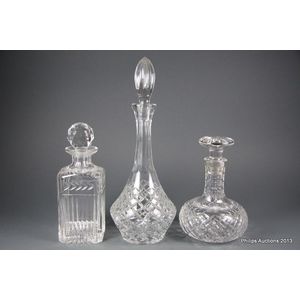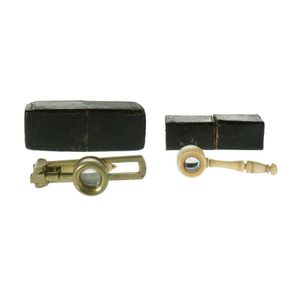18th Century Simple Microscope Set with Ivory Handle
You must be a subscriber, and be logged in to view price and dealer details.
Subscribe Now to view actual auction price for this item
When you subscribe, you have the option of setting the currency in which to display prices to $Au, $US, $NZ or Stg.
- Shagreen - Shagreen is the untanned smoothly pebbled textured skins of rays, sharks or dogfish. In finishing, it is dyed, mostly green, but the colour often fades to a cream colour. Shagreen was a popular material in Europe during the Art Deco era, when designers sought to mould the French tradition of luxury with exotic and precious materials. Most collectable items made from shagreen are smaller objects, like glasses cases, dagger and sword hilts, dressing accessories, boxes and picture frames.
- Ivory - Ivory is a hard white material that comes from the tusks of elephants, mammoth, walrus and boar, or from the teeth of hippopotamus and whales. The ivory from the African elephant is the most prized source of ivory. Although the mammoth is extinct, tusks are still being unearthed in Russia and offered for sale.
Ivory has been used since the earliest times as a material for sculpture of small items, both in Europe and the east, principally China and Japan.
In Asia ivory has been carved for netsuke, seals, okimono, card cases, fan supports, animals and other figures and even as carved tusks.
In the last 200 years in Europe ivory has been used to carve figures, for elaborate tankards, snuff boxes, cane handles, embroidery and sewing accessories, in jewellery and as inlay on furniture. Its more practical uses include being used for billiard balls, buttons, and a veneers on the top of piano keys.
The use and trade of elephant ivory have become controversial because they have contributed to Due to the decline in elephant populations because of the trade in ivory, the Asian elephant was placed on Appendix One of the Convention on International Trade in Endangered Species (CITES), in 1975, and in January 1990, the African elephant was similarly listed. Under Appendix One, international trade in Asian or African elephant ivory between member countries is forbidden. Unlike trade in elephant tusks, trade in mammoth tusks is legal.
Since the invention of plastics, there have been many attempts to create an artificial ivory
This item has been included into following indexes:
Visually similar items

Large Chinese blue and iron red vase, of tapering ovoid form, decorated with a continuous border of immortals, surrounded by ruyi head panels and flowers, height 52 cm

A group of three glass decanters one, ship's shaped diamond cut with a mushroom stopper; the second, square shouldered with fluted pattern and a ball stopper the other, carinate shaped with a tapered fluted neck and a spire stopper. Height 38 cm. Diameter

A cast iron kookaburra door stop, 30 x 20 cm

Pair Victorian silver plated centre piece bases, with figural base, 21 cm high approx.
